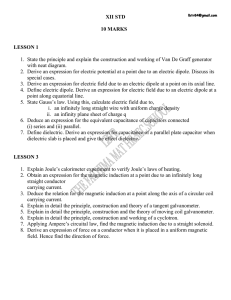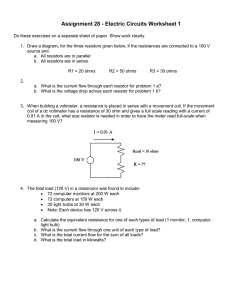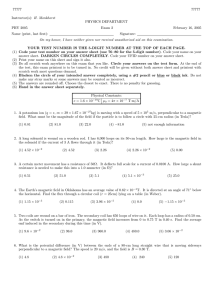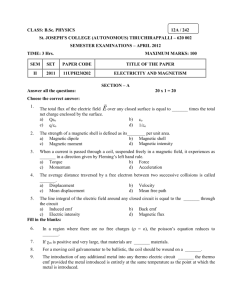Physics Time: 3 Hours Max. Marks: 70
advertisement
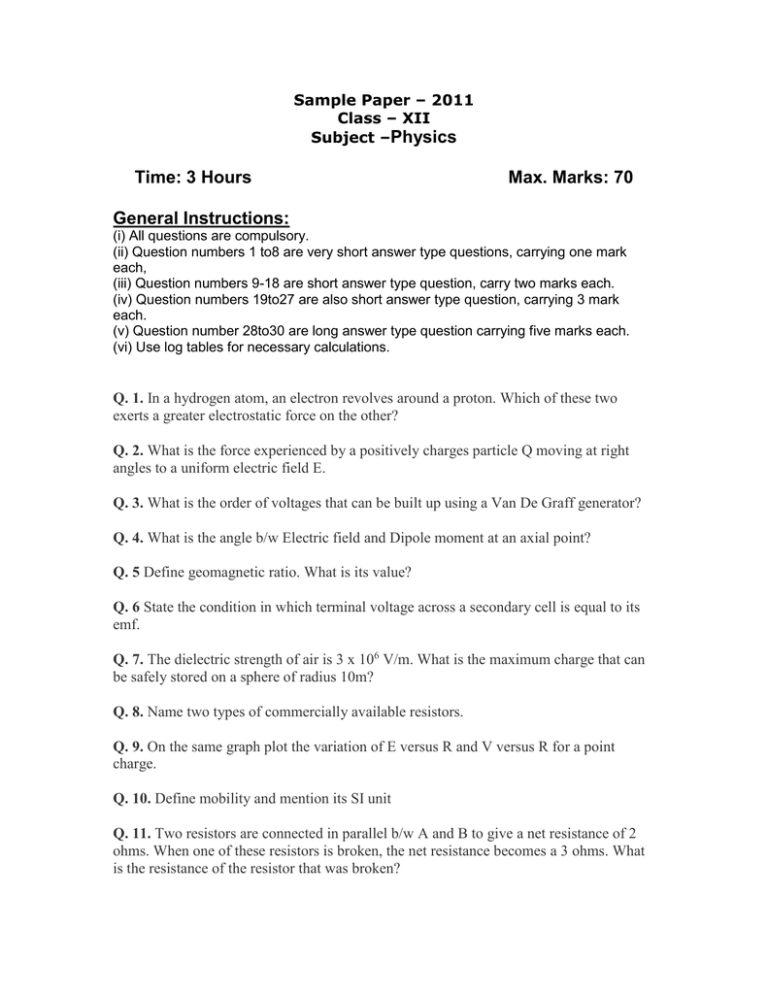
Sample Paper – 2011 Class – XII Subject –Physics Time: 3 Hours Max. Marks: 70 General Instructions: (i) All questions are compulsory. (ii) Question numbers 1 to8 are very short answer type questions, carrying one mark each, (iii) Question numbers 9-18 are short answer type question, carry two marks each. (iv) Question numbers 19to27 are also short answer type question, carrying 3 mark each. (v) Question number 28to30 are long answer type question carrying five marks each. (vi) Use log tables for necessary calculations. Q. 1. In a hydrogen atom, an electron revolves around a proton. Which of these two exerts a greater electrostatic force on the other? Q. 2. What is the force experienced by a positively charges particle Q moving at right angles to a uniform electric field E. Q. 3. What is the order of voltages that can be built up using a Van De Graff generator? Q. 4. What is the angle b/w Electric field and Dipole moment at an axial point? Q. 5 Define geomagnetic ratio. What is its value? Q. 6 State the condition in which terminal voltage across a secondary cell is equal to its emf. Q. 7. The dielectric strength of air is 3 x 106 V/m. What is the maximum charge that can be safely stored on a sphere of radius 10m? Q. 8. Name two types of commercially available resistors. Q. 9. On the same graph plot the variation of E versus R and V versus R for a point charge. Q. 10. Define mobility and mention its SI unit Q. 11. Two resistors are connected in parallel b/w A and B to give a net resistance of 2 ohms. When one of these resistors is broken, the net resistance becomes a 3 ohms. What is the resistance of the resistor that was broken? Q. 12. Using a suitable graph, explain why nichrome is used in standard resistance coils. Q. 13. A velocity selector is to be designed for particles of velocity 10m/s. What magnetic field should be employed if the electric field in it is 100 N/C Q. 14. Explain why a potentiometer is preferred over a voltmeter for measuring potential differences. Q. 15. An alpha particle and a proton accelerated by the same potential difference enter into a magnetic field. Find the ratio of their radius and the ratio of their frequency. Q. 16. In a meter bridge experiment with a fixed resistor of 10 ohm, the balance length is found to be 75cm. What resistance should be added in series with this fixed resistor so as to bring the null point in the center of the wire? Q. 17. The resistively of a metal X is 3.2 x 10-8 while the free electron density is 5 x 1028 m-3. Find the drift velocity of electrons if a potential gradient of 1 Vm-1 is applied across X. Q. 18. What type of materials are used for making a. Permanent magnets b. Transformer cores. Give two line reasons for each Q. 19. In the circuit, what is the reading of the voltmeter? What resistance should be connected in series with the R = 6 ohm resistor so the voltmeter reading become zero Q. 20. Show that the far field of a solenoid resembles that of a bar magnet. Hence define the magnetic moment of a solenoid. Q. 21. A long cylinder of radius Ro is carrying a current Io, which is uniformly distributed over its cross section. Derive an expression for the magnitude of magnetic field inside as well as outside the wire. Plot a curve to show the variation of magnetic field with radial distance. Q. 22. A and B are two concentric hollow metallic shells of radius RA and RB. A is given a charge QA while B is given a charge QB. Find the electric potential at a distance R from the center such that a. R < RA b. RA < R < RB c. R > RB Q. 23. Derive an expression for the torque acting on a current carrying loop placed in a uniform magnetic field. Hence define the magnetic moment of a current carrying loop. Q. 24. Use kirchoff’s laws to deduce the condition of a balanced Wheatstone bridge. Q. 25. Explain mathematically, why the resistance of metals increases while that of semiconductor decreases with the rise in temperature. Plot Resistance versus Temperature for Cu and for Silicon. Q. 26. Three charges Q , Q and – Q are placed on the vertices of an equilateral triangle of side L. Find the net force experienced by the charge Q and the net force experienced by the charge – Q. Q. 27. Cell A has an emf EA and internal resistance rA while cell B has emf EB and internal resistance rB. Derive an expression for the equivalent emf and internal resistance Q. 28. Using a labeled diagram explain the construction and working of a moving coil galvanometer. Define its current and voltage sensitivity and explain how they can be increased. (b) A galvanometer with a coil resistance of 5 ohm can tolerate a maximum current of 10mA. Explain how this can be converted into an ammeter of range 1A. Q. 29. There are a total of N cells each of emf E and internal resistance r. They are connected in the form of a 2 dimensional array of “n” rows each having equal number of cells. What is the maximum current that can be obtained from this combination? (b) This array is connected to an external resistor R. Derive an expression for the current flowing through R. For what value of R is this current maximum. Q. 30. Derive the value of potential due to an electric dipole at a point r distance away at an angle θ. On same graph show the variation of potential with distance for a point charge and for a dipole AJAY SHARMA 9414368091(aks.672@rediffmail.com)TAGORE PUBLIC SCHOOL CHIRAWA ROAD SURAJGARH(JHUNJHUNU)
